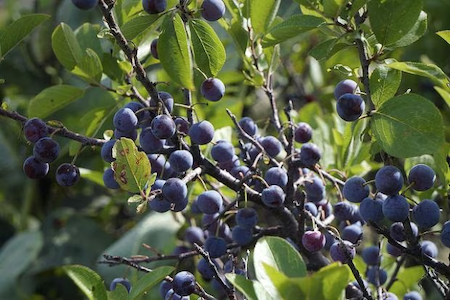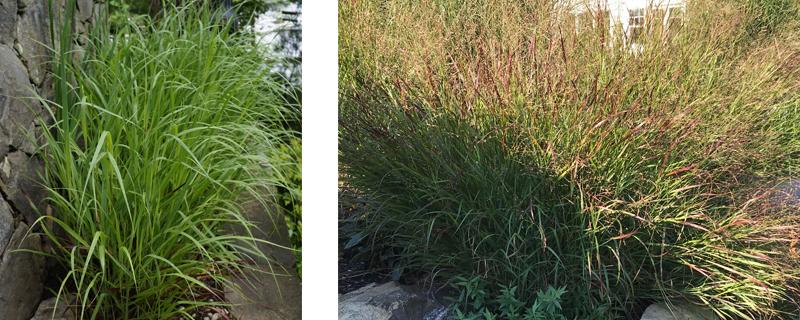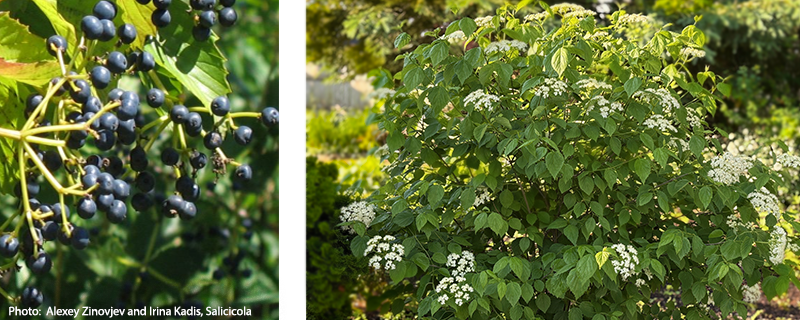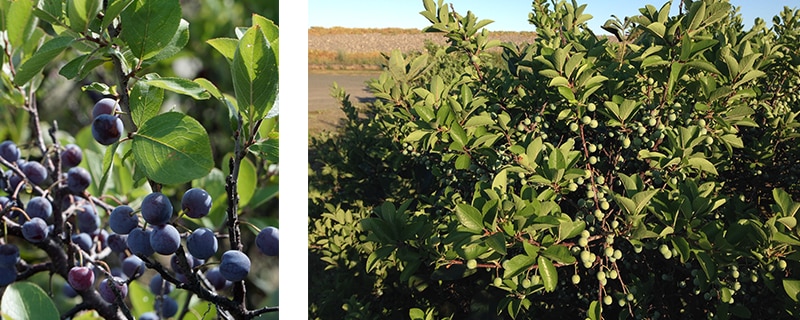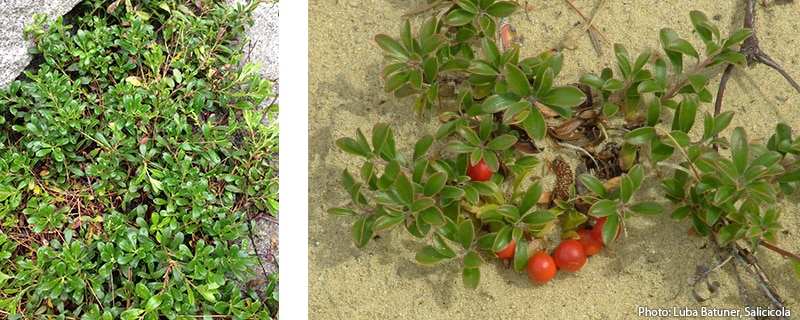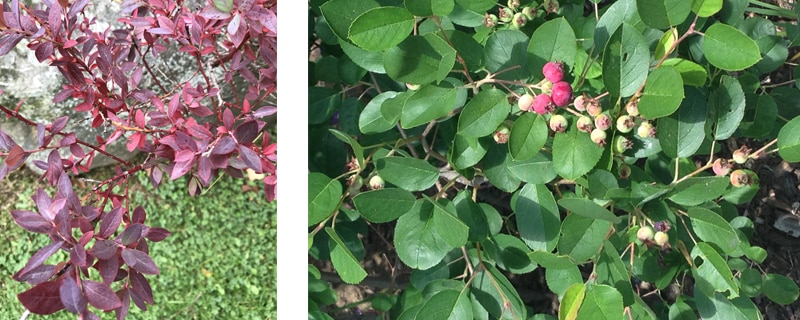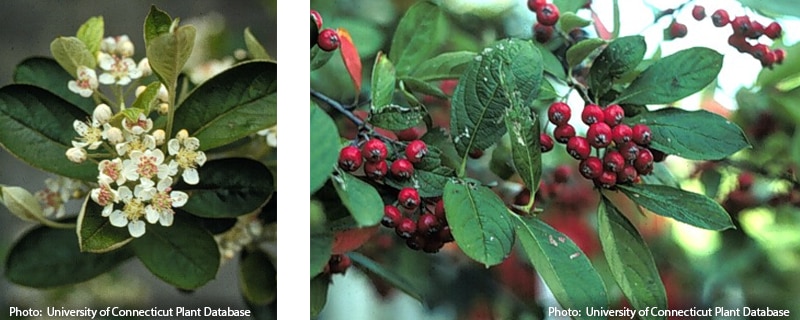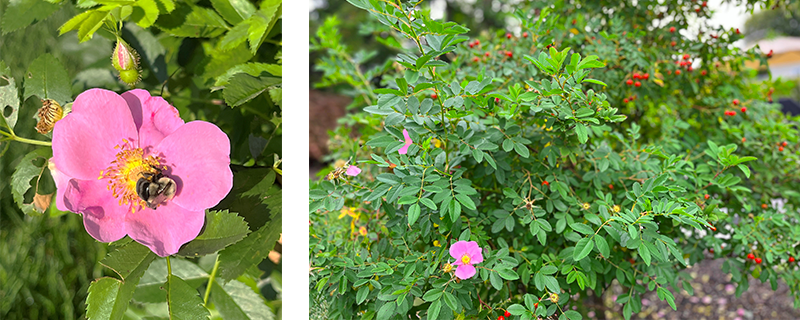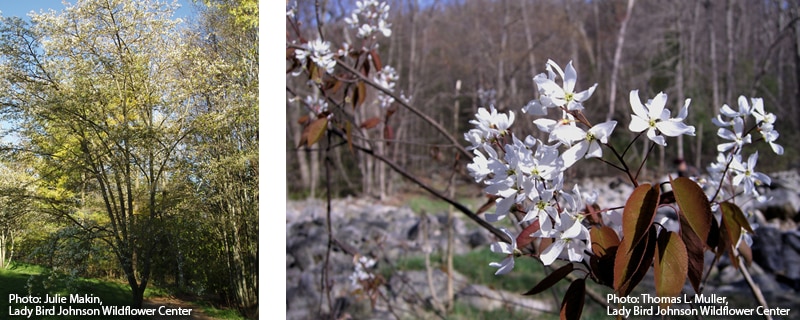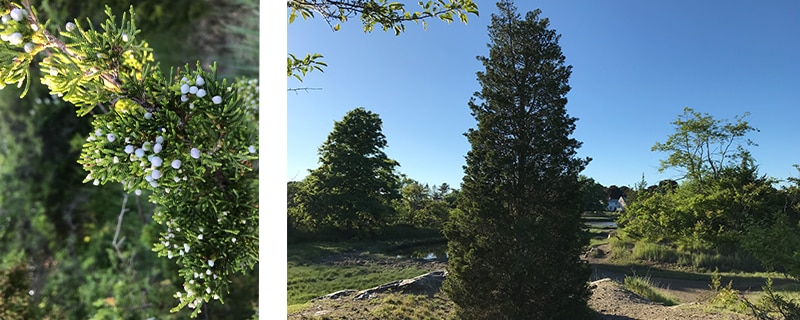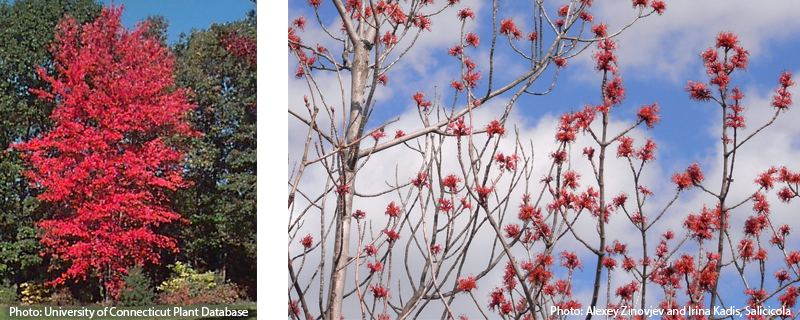Fall is an ideal time to plant because rainfall is usually plentiful and temperatures (and heat stress) are lower. In addition, in contrast to spring planting when soils are cool, the warm fall soil temperatures allow the roots of plants to grow until the ground freezes, setting the plants up for success the following spring. Fall plantings are also better equipped to survive the hot and dry conditions of the following summer because their more extensive root systems can capture water and nutrients more readily. And fall plantings can be beautiful. Many deciduous trees and shrubs offer vibrant colors and the bright-colored berries and stems of shrubs or the feathery flowers of grasses provide visual interest throughout the fall and winter. Their fruits also provide much needed food for wildlife. This web page offers information on fall planting for your coastal property.
Planting on the Coast
Coastal homeowners must be more selective in choosing plants that are suitable for the rigorous conditions of the coast, including salt spray, wind, sandy soils, and possibly even wave over-topping. Certain plants are well adapted to these conditions and may even provide the added benefits of erosion control and stabilization of soils. The following websites provide further information on planting on coastal sites, as well as offering descriptions of plant species.
- Coastal Landscaping - This site by the Massachusetts Office of Coastal Zone Management (CZM) provides information on the benefits of landscaping coastal property with native, hardy, salt-tolerant plant species for the primary purposes of providing storm damage prevention and erosion control. The site includes plant lists, sample landscape plans, and photographs and detailed information on particular plant species.
- Native Plant Trust - This website offers information on native plants, invasive species, conservation and research, plant courses, events, and a link to Go Botany—a Native Plant Trust website that provides identification keys to all of the plants in New England.
- PLANTS Database - This database by the United States Department of Agriculture (USDA) Natural Resources Conservation Service (NRCS) provides plant descriptions, characteristics and classification, distribution, and images.
- University of Connecticut Plant Database of Trees, Shrubs, and Vines - This site provides specifics on plant attributes—such as habitat, form, seasonal characteristics, culture, and landscape uses—accompanied by images.
- Salicicola - This website provides an online plant gallery with nearly 13,000 photos of more than 1,100 species found in eastern Massachusetts, as well as information on invasive plants; articles about trees, shrubs, and plants in the area; and plant checklists for many parks, reservations, and other natural areas within the region.
Tips for Fall Planting and Maintenance
The ideal period for fall planting on the Massachusetts coast is roughly six weeks before the first hard frost—generally September and October. Evergreens should be planted before mid-October since they continue to grow until the ground freezes, while deciduous plants can be planted anytime the ground is workable. To get the most out of your newly planted landscape throughout the fall and winter, a number of maintenance practices will help keep your yard well established, pest free, and healthy. Tips on watering, mulching, pruning, and more can be found on the following websites.
- Fall Maintenance Practices for Landscapes - This fact sheet by the University of Massachusetts Amherst Extension Program (UMass Extension) provides tips for fall maintenance, including cleanup, pruning, nutrient and water management, and mulching.
- Landscape, Nursery and Urban Forestry Program - This website by the UMass Extension program provides a series of fact sheets, publications, and services. The factsheets include detailed information on topics ranging from landscape culture and maintenance, to insects and diseases, to particular information on certain plant species.
- Ecological Landscaping Alliance (ELA) - The ELA website provides educational materials, conference and event information, and other links to promote the environmentally responsible stewardship of land and natural resources in landscaping and horticultural practices.
- CZ-Tip - The Fall and Winter Coastal Garden—Colors and Textures of Transition - This tip talks about how to add character to coastal gardens—particularly in fall and winter months—by planting trees, shrubs, perennials, and grasses with beautiful color, texture, form, and movement.
Planting American Beachgrass
The appropriate time to plant beachgrass differs from other plant species. "Cape" American Beachgrass typically does best when planted in unfrozen ground from mid-November through early-April—except in areas exposed to strong wind or waves, where it should be planted in early spring to reduce the likelihood that it will be washed or blown away in winter storms. The late spring and summer months are not optimal for planting because they are too warm and dry to support a bare-root plant. (Also note that if the area to be planted is located in rare species habitat, which for beachgrass projects is most likely to be shorebird or turtle nesting sites, the Natural Heritage and Endangered Species Program may require a permit under the Massachusetts Endangered Species Act. Permits often require conditions for planting, such as planting beachgrass before April 1 to protect shorebird breeding and nesting activities. For more information on permit requirements, see CZM’s Coastal Landscaping in Massachusetts - Do You Need a Permit? page.)
The following links provide additional information on planting American beachgrass:
- Coastal Dune Protection and Restoration: Using "Cape" American Beachgrass and Fencing (PDF, 3 MB) - This bulletin of the Woods Hole Sea Grant and Cape Cod Cooperative Extension Program address the restoration of a dune through case studies, tips, and other considerations, including preserving shorebird habitat and understanding the permit process.
- American Beachgrass Planting Guide (PDF, 74 KB) - This New York Sea Grant Extension Program fact sheet provides a summary of tips for planting American Beachgrass in beaches and dunes.
Using Native Plants
When choosing plants for your yard, select native species whenever possible. Native plants (i.e., those that originally grew in this area) are adapted to local conditions and consequently require less maintenance, watering, fertilizer, and pest control than introduced species. Many introduced species also become invasive and threaten the environment. To be sure that you don't inadvertently plant an invasive species in your yard, please check the following sources for the most current information:
- Evaluation of Non-Native Plant Species for Invasiveness in Massachusetts (PDF, 273 KB) - This Massachusetts Invasive Plant Advisory Group publication provides findings from plant evaluations of 85 species and includes an annotated list of invasive, likely invasive, and potentially invasive species in Massachusetts.
- Invasive Plant Atlas of New England - This website provides a comprehensive, web-accessible database of invasive and potentially invasive plants in New England.
- The Vascular Plants of Massachusetts: A County Checklist - This publication available on CD through the Natural Heritage and Endangered Species Program provides the names and distribution for more than 3,000 native and introduced plants found currently or historically in the various counties of the Massachusetts and indicates whether they are considered native, introduced, or invasive in the county.
- CZ-Tip - Coastal Plant Identification: Common Native and Invasive Species Found on the Massachusetts Coast - This tip provides descriptions and photographs of some of the more common native and non-native coastal plants in Massachusetts.
Top 10 Plants for Fall Planting on the Massachusetts Coast
The plants selected for coastal landscapes can be both functional and interesting. The following 10 native plants, which can be found at local nurseries (and are likely on sale in the fall), are great for coastal sites, provide fall and/or winter visual interest, and are bound to make an impact in your garden. (Be sure to check CZM's Coastal Landscaping website for important information on where to safely and effectively plant these species.)
For photos and additional information for most of the plant species listed below, see Coastal Landscaping in Massachusetts - Plant Highlights and Images.
Switchgrass - This perennial, clump-forming, warm-season grass has open, lacy sprays and reddish-purple seedheads. New foliage emerges fresh from the base in spring, and the bright green leaves that grow along the stem turn bright yellow in the fall. Switchgrass, with its deep fibrous roots, is an effective soil stabilizer on banks, sand dunes, and other erosion-prone areas.
Arrowwood Viburnum - This dense, multi-stemmed shrub typically grows 5-9 feet tall and wide. The leaves are either a shiny or flat dark green and turn yellow or red to red-purple in the late fall. The fruit, which can be of an intense blue color, is ornamental and a food source for birds.
Beach Plum - This fast-growing, deciduous shrub has an average height of 4-7 feet, but can reach heights of 10-12 feet in inland, nutrient-rich soils. In spring, snowy white flowers expand before the leaves, which are a dull-green color. The fruit ripens from August to October and can be harvested for jam, syrup, and puree.
Bearberry - This popular groundcover/low shrub choice has leathery, dark, evergreen leaves, small white/pink urn-shaped flowers, bright red berries, and thick growing character. It grows 6-12 inches high and spreads from 3-6 feet wide. The small flowers bloom from April to May and bright red fruits appear from August through the winter. The fruit is eaten by a few species of songbirds and other wildlife.
Highbush Blueberry - This shrub stands 6-12 feet tall and forms a crown. The flowers bloom in the spring and fruiting occurs from April to October. The berries provide food for many species of birds and mammals. The plants grow in full sun to partial shade, but those in open sites produce more flowers and have brighter fall foliage color.
Red Chokeberry - Growing from 6-10 feet tall and 3-5 feet wide, this spreading and colonizing shrub has numerous, slender stems. It can be transplanted easily and is valued for its summer flowers, persistent fruit, and colorful fall foliage.
Virginia Rose - This shrub grows 2-6 feet in height and has many spreading branches, thorny stems, and attractive flowers. The dark green, toothed leaves turn purplish-red in the fall. The ½-inch wide rose hips stay on the plant through winter, are edible, are high in Vitamin C and essential fatty acids, are a good food source for many animals, and can be used to make teas and medicines. The thicket-forming character provides a great hedge and good cover for birds and other animals.
Downy Serviceberry - This deciduous tree with a narrow oval crown reaches heights of 10-25 feet and can be single or multi-trunked. The clusters of white flowers grow at the branch tips before the leaves appear. The fall foliage is showy with orange, gold, red, and green. Many bird species and mammal species eat the fruit that tastes similar to but slightly tarter than blueberries.
Eastern Red Cedar - This 10-40 foot evergreen is excellent as a specimen planting and useful in masses for windbreaks and screening. The light blue berries are an important food source for many birds and mammals. In addition, cedars provide important protective cover for nesting, roosting, and winter shelter.
Red Maple - A wide-ranging deciduous tree that typically grows from 40-70 feet tall, Red Maple is often one of the first trees to change color—from greenish yellow to vibrant scarlet to burgundy. It is relatively fast growing, tolerant of many conditions, and adaptable. Red Maples are useful as shade trees, for wet sites, for their striking fall foliage, and for their wildlife value—their seeds provide food for squirrels and birds.
